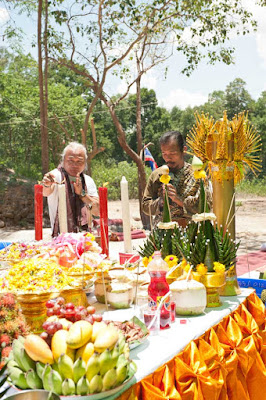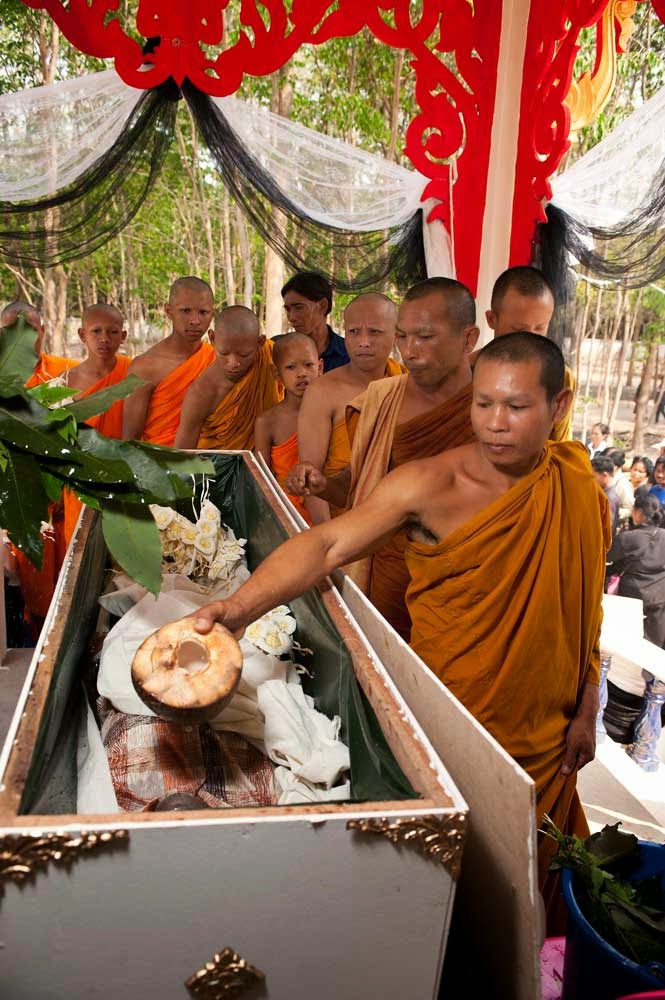 |
| Ruesi In Front of New Chedi At Wat Pa Khao Suan Kwang |
June 1st was a sort of Memorial Day here in Thailand as well as many other countries in which Theravada Buddhism is dominate. The day was a special day not related to soldiers or the sacrifices of soldiers in wars for their country. The day was a special day to pay homage to three milestones in the life of Lord Buddha.
There are three holy days for Theravada Buddhists. Unlike Catholic "Holy Days of Obligation" when people are obligated to attend Mass and behave a certain way for the day, Buddhist Holy Days are special days, public holidays in some countries, where the people show their devotion and earn extra merit in their journey to enlightenment.
The three special days are denoted by the word "Bucha" which means "pay homage". The days are Makha Bucha, Asaraha Bucha, and Visakha Bucha.
This year Visakha Bucha fell on 1 June. The date varies each year in synch with the lunar cycle - it is the full moon of the Indian lunar month of Wisaka. Indian? Yes, Buddhism started in India or rather what is called India today. Buddha was a crown prince of the Kingdom of Sakyas.
"Visakha"? "Wisaka"? "Wisakha"? Further manifestations of the common Thai expression "Same Same but different." One of the issues with living in Thailand is the many variations in spelling for Thai words that have been converted to the Latin alphabet. In the case of these three words there is the added complication that the word was originally an Indian word. No matter the case they all refer to the same day.
Crown Prince Siddharta Gautama, who became Lord Buddha, was born, became enlightened 35 years later and died at the age of 80 - all on the same day of the year. All three anniversaries are celebrated on Visakha Bucha.
 |
| Devotees Attending Late Morning Ritual |
Visakha Bucha is a full day of celebration and ritual. People dress in white for the day which starts with the daily merit making of offering food to the Monks, parties and parades often take up the day and during the evening at many locations there are candlelight processions of devotees.
During the evening, the devotees carry a lighted candle, three smoldering Joss (incense) sticks, and a Lotus bud. In homage to the three gems of Buddhism - Buddha, The Teachings of Buddha, and the Sanga (Buddhist religious community), the devotees will walk three times clockwise around the shrine of the location.
After the procession there are often religious lectures as during the day.
Wat Pa Khao Suan Kwang was having another special ritual for the day involving the new chedi on the grounds. Construction of the chedi, also known as a stupa, has progressed well since our last visit. Although not 100% completed, the structure has been painted gold and the scaffolding had been removed. Later I walked onside at the grade level and discovered that the tile floor was almost completed.
 |
| Ruesi Lights Candles For Ritual |
 |
| Some of the many Pahn (Pha Kwan) |
 |
| Peelawat and Duang Making Offerings |
From one of the women that we met during our last visit to the Wat, we learned that the purpose of the day's special ritual was to call down the angels and spirits to come down from the heavens to pprotect the people from bad luck, misfortune, and evil ... especially evil spirits.
I learned that there were 16 levels of "heaven" in Buddhism - 16 planes of heavenly beings outside of the "sense world". There actually 31 planes of existence in Buddhism - 1 is the plane of humans. There are four planes of deprivation - sort of like hell - if there was such a place in Buddhism. The other planes are for concepts that I do not understand ... yet
No matter, the Ruesi with the assistance of the tapatakao performed a ritual in conjunction with all the offerings on the shrine or altar to beseech the angels and heavenly spirits to come down to help the people and to occupy the chedi. Throughout the ritual, devotees raised their heads and shielded their eyes glazing up at the Sun. During my last visit, I was told that when the spirits and angels come you can see changes in the light and manifestations of them across the Sun. Again as I have written a few times before, I do not necessarily believe but I strive to accurately share what I am told or see - with no judgements.
 |
| Shrine with Offerings of Burning Joss Sticks, Food, Flowers, Pahn, and Fanta (Pineapple, Orange & Banana Flavor) |
Part way through the ritual, for some unknown reason, I entered the chedi. I entered at the ground level - the first of three levels. No doubt the three level being in recognition of the Three Gems of Buddhism. The first level had a ceramic tile floor not much different than you can find in a typical home. There was no access to the floors above the ground floor. However in the center of the room there was a hole in the ceiling. The hole was directly aligned with another hole in the ceiling of the second level as well as the ceiling of the third level which through a small diameter tower ended up beneath the "eye of the Naga" which had been installed during the chedi consecration.
I thought that it might be interesting to take a photograph of the sky directly up and through the "eye of the Naga" To ensure that I got the proper orientation as well as alignment, I laid down on the tile floor to take the shot. It did not see all that special to me, so after three more shots I moved on to other things of interest.
After the ritual concluded, Duang spoke with the Ruesi about our up-coming trip to America. He ended up giving her a blessing for a safe and happy trip. We have a division of labor in regards to our travels. I do the planning, and making the arrangements. Duang tends to the spiritual aspects. It works out well.
That evening at the Wat there was going to be an ordination of some Buddhist Nuns. It sounded like a great opportunity and experience. However it had already been a long day, another very hot day, and our grandson had school the next day so we decided to head home.
In the past week I have been busy editing and post processing photos from several days. I eventually got around to doing most of the photos from Wisakha Bucha day. I shared the results with Duang as I do with all my shoots. She is always very complimentary and supportive. However there was one photo that she was particularly excited about - the photo taken inside the chedi up through the "eye of the Naga"
Where I, from my perspective and experience, saw some reflection and refraction of sunlight through a glass ball, Duang saw manifestation of the arrival of angels and spirits from the levels of "heaven"
We all make our own reality based upon our individual perspectives and experiences. Who is to say that anyone person's reality is more real or superior than another's?
What I do know is that life in "Allen's World" is much more interesting knowing and sharing in other's "reality" Just as there are many roads as well as paths to a destination, and many ways to accomplish a task or goal, there are many different beliefs. These are all aspects that make life interesting.


























































